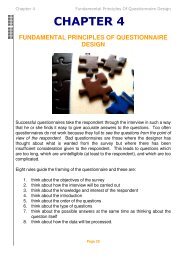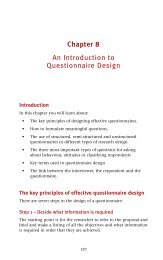The growing business handbook : inspiration and advice ... - Sparkler
The growing business handbook : inspiration and advice ... - Sparkler
The growing business handbook : inspiration and advice ... - Sparkler
Create successful ePaper yourself
Turn your PDF publications into a flip-book with our unique Google optimized e-Paper software.
66 Ideas <strong>and</strong> innovation<br />
patents) from other companies <strong>and</strong> individuals. In addition, internal inventions not<br />
being used in a firm’s <strong>business</strong> should be taken outside the company through licensing,<br />
joint ventures, spin-offs etc.<br />
In fact, open innovation can be broken down into five distinct areas: open source,<br />
consumer- or user-led crowdsourcing, expert knowledge-led crowdsourcing,<br />
proposition sourcing (involving entrepreneurs), <strong>and</strong> concept sourcing (involving<br />
professional originators). All are outlined in more detail below.<br />
1. Open source<br />
New <strong>and</strong> shared knowledge, enabling reputation <strong>and</strong> status-building<br />
Open source is a practice most common in software development <strong>and</strong> digital<br />
productions, where enthusiasts (of music, for instance) share knowledge, code <strong>and</strong><br />
digital files to build reputations or contribute to end products.<br />
Software companies use open source to encourage web developers to build on<br />
their platforms in order to make money from upgrades <strong>and</strong> end-user licenses for<br />
support products, <strong>and</strong> thus have a vested interest in free shareware. In this sense,<br />
‘free’ does not mean valueless.<br />
Shared ideas can become valuable if those ideas make a contribution to a greater<br />
end product that is worth money. In a structured framework focused on a common<br />
goal <strong>and</strong> with profit-share agreements in place, this is considered co-creation. In an<br />
unstructured open source environment, enthusiasts or new practitioners are often<br />
more interested in enabling <strong>and</strong> reputation-building than making money.<br />
<strong>The</strong> results of publicly funded university research discoveries are made freely<br />
available through journals publication, allowing open source access to all who<br />
purchase or download them. However, although universities are strongly encouraged<br />
to commercialize results using traditional IPR <strong>and</strong> knowledge-transfer methodologies,<br />
small discoveries <strong>and</strong> new technologies are chasing problems to address but lack any<br />
real market application. So this is a form of open source, though not necessarily an<br />
immediately practical one.<br />
IP structure: A Creative Commons license was introduced some years ago to<br />
denote materials that are free to use without seeking permission. Open source can<br />
build new knowledge; spawn innovation, new products <strong>and</strong> <strong>business</strong>es. It serves a<br />
purpose to those who make a personal decision to work in such a way.<br />
2. Consumer- or user-led crowdsourcing<br />
User insights, ideas-based competitions, PR, no defined problem, no safety or quality<br />
control<br />
User-led crowdsourcing is a modern form of consumer insight research that has<br />
replaced the small focus groups used by traditional market research firms. Large<br />
corporate br<strong>and</strong> owners launch competitions, often through PR firms, to source new<br />
product ideas <strong>and</strong> improvements from a consumer or user base; an expert panel sifts








